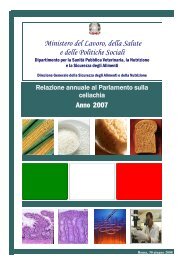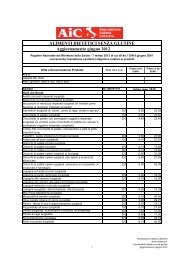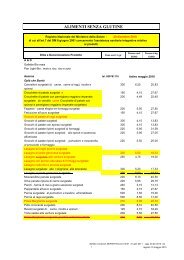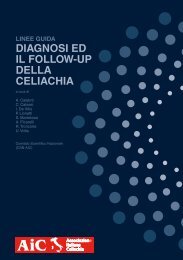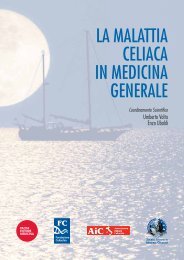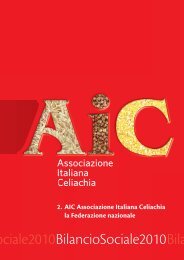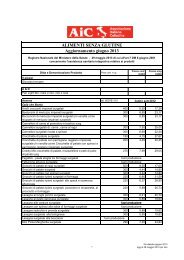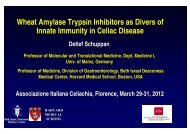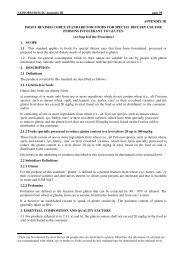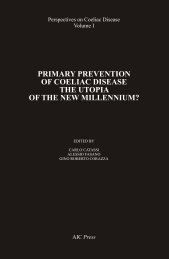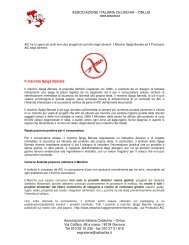Genetics and risk for associated autoimmune disorders and ...
Genetics and risk for associated autoimmune disorders and ...
Genetics and risk for associated autoimmune disorders and ...
Create successful ePaper yourself
Turn your PDF publications into a flip-book with our unique Google optimized e-Paper software.
<strong>Genetics</strong> <strong>and</strong> <strong>risk</strong> <strong>for</strong> <strong>associated</strong> <strong>autoimmune</strong><br />
<strong>disorders</strong> <strong>and</strong> refractory coeliac disease<br />
Alex<strong>and</strong>ra Zhernakova/ Cisca Wijmenga<br />
University Medical Center Groningen<br />
The Netherl<strong>and</strong>s<br />
c.wijmenga@umcg.nl
Celiac disease is a classical complex disorder<br />
HLA<br />
Non-HLA<br />
Gluten,<br />
other factors
Gluten is not the sole cause of celiac disease<br />
+ + Other non-<br />
HLA genes<br />
= ><br />
Celiac<br />
Disease<br />
wheat,<br />
barley, rye<br />
HLA DQ2/DQ8<br />
Other env factors 40% of heritability 60% of heritability
<strong>Genetics</strong> of celiac disease has progressed slowly<br />
Linkage analysis<br />
C<strong>and</strong>idate gene association studies<br />
HLA<br />
CTLA4<br />
1973 1997 1998 1999 2000 2001 2002 2003 2004 2005 2006 2007 2008 2009
<strong>Genetics</strong> of celiac disease has progressed slowly<br />
Genome-wide<br />
association<br />
(GWA) studies<br />
Linkage analysis<br />
C<strong>and</strong>idate gene association studies<br />
HLA<br />
CTLA4<br />
1973 1997 1998 1999 2000 2001 2002 2003 2004 2005 2006 2007 2008 2009
… in 1000s of patients <strong>and</strong> controls<br />
100-1000s of patients<br />
(cases)<br />
100s-1000s of healthy<br />
individuals (controls)<br />
DNA from cases<br />
DNA from controls<br />
SNP ‘chip’ (>500,000 SNPs)<br />
One <strong>for</strong> each case DNA<br />
Compare differences to discover<br />
SNPs <strong>associated</strong> to disease<br />
SNP ‘chip’ (>500,000 SNPs)<br />
One <strong>for</strong> each control DNA
GWAS have led to a revolution in human genetics (complex diseases)<br />
Revolutie in genetisch onderzoek
GWAS have led to a revolution in human genetics (complex diseases)<br />
Revolutie in genetisch onderzoek
GWAS have led to a revolution in human genetics (complex diseases)<br />
Revolutie in genetisch onderzoek
GWAS have led to a revolution in human genetics (complex diseases)<br />
Revolutie in genetisch onderzoek
GWAS have led to a revolution in human genetics (complex diseases)<br />
Revolutie in genetisch onderzoek<br />
June 2011: 1449<br />
loci at p≤5x10 -8<br />
<strong>for</strong> 237 traits
Celiac disease: one of the GWAS success stories to identify non-HLA <strong>risk</strong> factors<br />
50<br />
40<br />
30<br />
no. of CD Loci<br />
20<br />
10<br />
0<br />
2007 2008 2009 2010 2011
What did we learn from GWAS?<br />
Looking insight the<br />
<strong>associated</strong> loci…
Celiac disease-<strong>associated</strong> variants are common <strong>and</strong> show modest effect (OR
HLA <strong>and</strong> non-HLA variants can explain ~50% of genetic variation<br />
ETS1<br />
1q<br />
RUNX3<br />
PLEK<br />
CCR4<br />
ZIMIZ1<br />
8q<br />
NFIA<br />
ELMO1
The 39 non-HLA loci represent 115 genes<br />
Genes with a function in the immune system are depicted in blue (25 loci, 44 genes)<br />
13<br />
12<br />
11<br />
10<br />
9<br />
8<br />
7<br />
6<br />
5<br />
4<br />
3<br />
2<br />
1<br />
1p31.3<br />
1p36.11<br />
1p36.23<br />
1p36.32<br />
1q24.2<br />
1q24.3<br />
1q31.2<br />
1q32.1<br />
2p14<br />
2p16.1<br />
2q12.1<br />
2q31.3<br />
2q33.2<br />
3p14.1<br />
3p21.31<br />
3p22.3<br />
3q13.33<br />
3q25.33<br />
3q26.2<br />
3q28<br />
4q27<br />
6p25.3<br />
6q15<br />
6q22.33<br />
6q23.3<br />
6q25.3<br />
7p14.1<br />
8q24.21<br />
10q22.3<br />
11q24.13<br />
12q24.12<br />
13q14.2<br />
14q24.1<br />
16p13.13<br />
17q21.3<br />
18p11.2<br />
21q22.3<br />
22q11.21<br />
Xp22.2<br />
Gutierrez-Achury et al., J Int Med 2011
25 celiac disease-<strong>associated</strong> GWAS loci overlap with other immune-mediated loci<br />
13<br />
12<br />
11<br />
10<br />
9<br />
8<br />
7<br />
6<br />
5<br />
4<br />
3<br />
2<br />
1<br />
1p31.3<br />
1p36.11<br />
1p36.23<br />
1p36.32<br />
1q24.2<br />
1q24.3<br />
1q31.2<br />
1q32.1<br />
2p14<br />
2p16.1<br />
2q12.1<br />
2q31.3<br />
2q33.2<br />
3p14.1<br />
3p21.31<br />
3p22.3<br />
3q13.33<br />
3q25.33<br />
3q26.2<br />
3q28<br />
4q27<br />
6p25.3<br />
6q15<br />
6q22.33<br />
6q23.3<br />
6q25.3<br />
7p14.1<br />
8q24.21<br />
10q22.3<br />
11q24.13<br />
12q24.12<br />
13q14.2<br />
14q24.1<br />
16p13.13<br />
17q21.3<br />
18p11.2<br />
21q22.3<br />
22q11.21<br />
Xp22.2<br />
CeD<br />
T1D<br />
CrD<br />
UC<br />
RA<br />
Gutierrez-Achury et al., J Int Med 2011
Shared genetics suggests shared immune genes<br />
Immune genes fall into 5<br />
broad categories:<br />
• Cell signaling<br />
• Cell migration<br />
• Cytokines<br />
• NFkB activity<br />
• T cells<br />
Gutierrez-Achury et al., J Int Med 2011
Shared genetics is not limited to immune-related diseases<br />
Can this explain the<br />
extra-intestinal<br />
manifestations?<br />
Trynka et al., Trends Mol Med 2010
We should be careful. Loci may look the same but could be different …<br />
Trynka et al., Gut 2009
GWAS is done. What’s next?<br />
• <strong>Genetics</strong><br />
• Narrowing the region<br />
• Identification of the casual variant(s)<br />
• Fine-mapping<br />
• Cross-population studies<br />
• Cross-disease studies<br />
• Missing heritability<br />
• Low frequency variants<br />
• Identification of downstream effects<br />
• Pathway analysis<br />
• Expression studies
ImmunoChip – fine-mapping <strong>and</strong> shared immune genetics<br />
<br />
12 AID study groups: T1D, IBD, RA, CoelD, MS, SLE...<br />
<br />
189 distinct loci <strong>associated</strong> to immune-related diseases<br />
<br />
1kG (<strong>and</strong> individual ef<strong>for</strong>ts) sequence variants<br />
<br />
Dense HLA genotyping<br />
<br />
All together – 200K samples
10-20x greater SNP density than Hap550 (post-QC)
13 new loci identified, making the total number of non-HLA loci 39<br />
Novel loci = blue<br />
Loci with multiple signals = grey highlight
~50% of cases: Multiple common independent SNPs, including rare variants (< 5%)<br />
13 loci show independent second (or third) signal<br />
Intron 10 SNP<br />
MAF 0.058<br />
P 8.4x10 -9<br />
Intron 3 SNP<br />
MAF 0.296<br />
P 1.3x10 -6<br />
Intron 3 SNP<br />
MAF 0.119<br />
P 2.6x10 -4<br />
54 independent non-HLA signals in 39 loci<br />
29 signals could be localized to a single gene
Cross ethnic mapping<br />
Different<br />
LD block<br />
Discovery sample<br />
Associated SNP<br />
Causal variant<br />
Follow-up sample<br />
We can narrow down several loci, including IL2-IL21 block
So far one paper was published <strong>for</strong>m Immunochip data<br />
• In celiac disease!
Cross-disease meta-analysis - co-morbid diseases<br />
Type 1 diabetes<br />
Celiac disease<br />
Rheumatoid arthritis<br />
Multiple sclerosis<br />
Ankylosing<br />
spondylitis<br />
SLE<br />
Crohn’s disease<br />
Autoimmune<br />
thyroid disease<br />
Psoriasis<br />
Ulcerative Colitis<br />
Asthma
Meta-analysis: 14 shared CeD-RA loci, including 4 new loci<br />
CeD<br />
31 ‘unique’ loci; 15<br />
shared<br />
8q24<br />
CD247<br />
CD28-ICOS-CTLA4<br />
DDX6<br />
HLA<br />
IL2-21<br />
REL<br />
SH2B3<br />
STAT4<br />
TAGAP<br />
TNFAIP3<br />
TNFRSF14<br />
TRAF1-C5<br />
UBASH3A<br />
UBE2L3<br />
RA<br />
31 ‘unique’ loci; 15<br />
shared<br />
Implicates antigen presentation <strong>and</strong> T-cell activation as a shared mechanism
Downstream effect – how severe the damage is?<br />
Deleterious mutation?<br />
Or regulatory variants?
most association signals are non-coding<br />
Only 3 protein-altering variants were identified<br />
Approx. 50% of <strong>associated</strong> SNPs show eQTL effects
Example of an eQTL from the celiac region on 2q12.1<br />
The strongest <strong>associated</strong> SNP<br />
from the <strong>associated</strong> region has<br />
a cis-regulatory effect on<br />
IL18RAP expression;<br />
The celiac disease <strong>risk</strong> allele is<br />
<strong>associated</strong> with low transcript<br />
levels of this gene.
Example of an eQTL from the celiac region on 2q12.1<br />
The strongest <strong>associated</strong> SNP<br />
from the <strong>associated</strong> region has<br />
a cis-regulatory effect on<br />
IL18RAP expression;<br />
The celiac disease <strong>risk</strong> allele is<br />
<strong>associated</strong> with low transcript<br />
levels of this gene.
Building the co-expression networks helps establishing the key pathways<br />
Network construction using co-expression of genes<br />
Point to genes with potential rare <strong>risk</strong> variants?
Major role of immune-related pathways<br />
Importance of the thymus<br />
THEMIS, TNFRSF14, RUNX3, ETS1<br />
Innate immune detection of viral RNA<br />
UBE2E3, BACH2, TNFAIP3, TLR7, TLR8<br />
T-<strong>and</strong> B-cell co-stimulation<br />
CTLA4- ICOS-CD28, TNFRSF14,<br />
CD80, ICOSLG, TNFRSF9, TNFSF4<br />
Prevention from uncontrolled self-<br />
Reactivity = tolerance<br />
Role <strong>for</strong> rotavirus infections?<br />
• These processes are partly shared with other immune-mediated diseases<br />
• There are still many more genetic factors to be discovered
Refractory Celiac Disease (RCD)<br />
A subgroup of celiac patients (≈ 5%) develops resistance to GFD<br />
Malamut <strong>and</strong> Cellier, Am J Gastroenterol 2011
Association analysis strategy in RCDII in GWAS dataset<br />
Discovery cohort<br />
Dutch cohort<br />
RCDII cases, n = 38<br />
Healthy controls, n= 846<br />
Hap550k SNPs<br />
MAF > 0.01<br />
HWE P > 0.00001<br />
Fisher’s exact test<br />
Top 15 loci with P < 10-5<br />
Replication cohorts<br />
1. France: RCDII cases, n = 33<br />
Healthy controls, n= 787<br />
2. Italy: RCDII cases, n = 8+<br />
Healthy controls, n = 543<br />
3. Dutch: RCDII cases, n = 7<br />
Courtesy Vinod Kumar
Manhattan plot: Association between RCDII <strong>and</strong> healthy controls at 550K SNPs<br />
Lambda = 1.0226<br />
Chromosomes<br />
Courtesy Vinod Kumar
RCDII GWAS non-HLA top hits: No celiac susceptibility loci<br />
RCDII cases vs Healthy control<br />
RCDII cases vs non-RCD celiac cases<br />
CHR SNP A1 F_A F_U A2 P OR A1 F_A F_U A2 P OR<br />
16 SNP1 T 0,447 0,200 C 2,00E-006 3,24 T 0,447 0,185 C 3,58E-07 3,58<br />
10 SNP2 A 0,013 0,179 G 1,42E-005 16,36 A 0,013 0,186 G 8,07E-06 17,14<br />
17 SNP3 C 0,263 0,089 T 1,54E-005 3,65 C 0,263 0,093 T 3,07E-05 3,47<br />
13 SNP4 A 0,447 0,218 G 1,60E-005 2,91 A 0,447 0,221 G 2,00E-05 2,86<br />
14 SNP5 G 0,513 0,277 A 2,35E-005 2,76 G 0,513 0,241 A 9,97E-07 3,33<br />
5 SNP6 A 0,408 0,191 G 2,38E-005 2,92 A 0,408 0,208 G 1,51E-04 2,63<br />
16 SNP7 A 0,026 0,192 C 3,21E-005 8,80 A 0,026 0,193 C 4,92E-05 8,83<br />
14 SNP8 T 0,197 0,428 C 4,25E-005 3,04 T 0,197 0,431 C 3,90E-05 3,08<br />
10 SNP9 T 0,224 0,073 G 4,78E-005 3,68 T 0,224 0,079 G 1,35E-04 3,36<br />
11 SNP10 A 0,711 0,470 G 5,07E-005 2,76 A 0,711 0,475 G 8,09E-05 2,72<br />
17 SNP11 T 0,684 0,447 C 5,19E-005 2,68 T 0,684 0,452 C 8,35E-05 2,62<br />
15 SNP12 C 0,000 0,131 T 5,26E-005 0,00 C 0,000 0,129 T 5,08E-05 0,00<br />
18 SNP13 A 0,013 0,161 G 6,06E-005 14,43 A 0,013 0,164 G 5,94E-05 14,73<br />
2 SNP14 T 0,211 0,067 C 6,41E-005 3,73 T 0,211 0,066 C 6,20E-05 3,77<br />
16 SNP15 T 0,079 0,271 C 8,09E-005 4,34 T 0,079 0,296 C 1,10E-05 4,90<br />
1. False positive findings is a problem due to the GWAS design; => replication<br />
step required.<br />
2. False negatives of associaiton will be a major problem in small discovery<br />
samples, even if the effects are large.<br />
Courtesy Vinod Kumar
RCDII: Replication study using French cohort<br />
Replication cohorts<br />
1. France: RCDII cases, n = 33<br />
Healthy controls, n= 787<br />
2. Italy: RCDII cases, n = 8+<br />
Healthy controls, n = 543<br />
3. Dutch: RCDII cases, n = 7+<br />
CHR SNP A1 F_A F_U A2 P_Fisher's Exact OR<br />
16 SNP1 T 0,197 0,194 C 1,00E+00 1,016<br />
10 SNP2 T 0,121 0,151 C 6,00E-01 0,777<br />
17 SNP3 C 0,106 0,088 T 6,55E-01 1,235<br />
13 SNP4 A 0,364 0,251 G 4,44E-02 1,703<br />
14 SNP5 G 0,242 0,259 A 8,86E-01 0,917<br />
5 SNP6 T 0,227 0,233 C 1,00E+00 0,967<br />
16 SNP7 T 0,359 0,208 G 7,35E-03 2,139<br />
14 SNP8 T 0,424 0,461 C 6,15E-01 0,863<br />
10 SNP9 T 0,076 0,062 G 6,04E-01 1,231<br />
11 SNP10 A 0,422 0,482 G 3,74E-01 0,786<br />
17 SNP11 A 0,394 0,453 G 3,78E-01 0,785<br />
15 SNP12 C 0,076 0,119 T 4,31E-01 0,61<br />
18 SNP13 T 0,182 0,14 C 3,66E-01 1,36<br />
2 SNP14 T 0,091 0,082 C 8,18E-01 1,12<br />
16 SNP15 A 0,182 0,249 G 2,45E-01 0,67<br />
Courtesy Vinod Kumar
Regional association plot at SNP4 on chr 13<br />
SNP 4: Meta-P = 2.85 x 10 -6<br />
Courtesy Vinod Kumar
Kruppel-like factor -12 (KLF12) : Biology<br />
1. The protein encoded by this gene is a member of the Kruppellike<br />
zinc finger protein family.<br />
2. It can repress expression of the AP-2 alpha gene by binding to a<br />
specific site in the AP-2 alpha gene promoter. (Activator protein-2 alpha (AP-2 alpha)<br />
is a developmentally-regulated transcription factor <strong>and</strong> important regulator of gene expression during vertebrate development<br />
<strong>and</strong> carcinogenesis).<br />
3. It is highly expressed in CD3+ T cells.<br />
In plan - Exome-arrays (Illumina) to detect coding variants <strong>associated</strong><br />
with RCDII
General discussion <strong>and</strong> conclusions<br />
• RCDII – increasing the sample size. Exome sequencing<br />
• GWAS studies have identified 39non-HLA loci <strong>for</strong> celiac disease<br />
• Common variants with small effect sizes (OR
Acknowledgements celiac disease research<br />
Cisca Wijmenga, Nick Bockett, Rodrigo Coutinho de Almeida, Cleo van<br />
Diemen, Patrick Dubois, Jingyuan Fu, Javier Gutierrez-Achury, Graham<br />
Heap, Barabra Hrdličková, Karen Hunt, Juha Karjalainen, Vanisha Mistry, Isis<br />
Ponce, Vinod Kumar, Harm-Jan Westra, Sebo Withoff, Lude Franke, Jihane<br />
Romanos, Sasha Zhernakova, Agata Szperl, Gosia Trynka, Noortje Festen<br />
Collaborators<br />
David van Heel<br />
Maria Teresa Bardella<br />
Donatella Barosani<br />
Sjoerd Bakker<br />
Thelma BK<br />
Chris Cotsapas<br />
Bozena Cukrowska<br />
Carlo Catassi<br />
Mark Daly<br />
Luigi Greco<br />
Luisa Mearin<br />
V<strong>and</strong>ana Midah<br />
Chris Mulder<br />
Mihai Netea<br />
Robert Plenge<br />
Anna Rybak<br />
Paivi Saavalainen<br />
Sabyasachi Senapati<br />
Ajit Sood<br />
Rinse Weersma<br />
Victorien Wolters<br />
PreventCD Study Group





